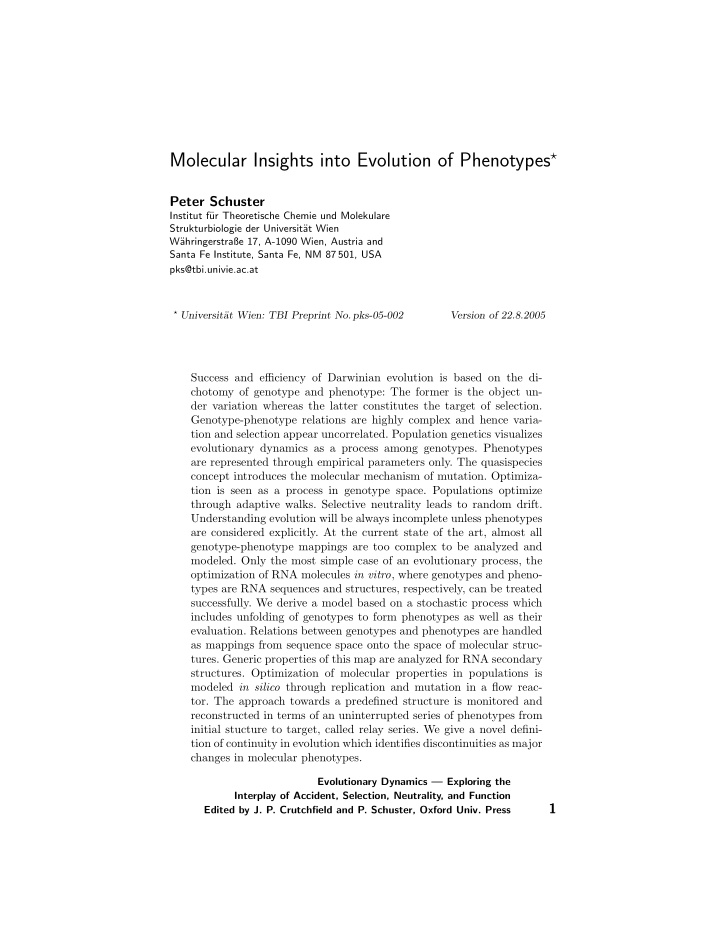



Molecular Insights into Evolution of Phenotypes ⋆ Peter Schuster Institut f¨ ur Theoretische Chemie und Molekulare Strukturbiologie der Universit¨ at Wien W¨ ahringerstraße 17, A-1090 Wien, Austria and Santa Fe Institute, Santa Fe, NM 87 501, USA pks@tbi.univie.ac.at ⋆ Universit¨ at Wien: TBI Preprint No. pks-05-002 Version of 22.8.2005 Success and efficiency of Darwinian evolution is based on the di- chotomy of genotype and phenotype: The former is the object un- der variation whereas the latter constitutes the target of selection. Genotype-phenotype relations are highly complex and hence varia- tion and selection appear uncorrelated. Population genetics visualizes evolutionary dynamics as a process among genotypes. Phenotypes are represented through empirical parameters only. The quasispecies concept introduces the molecular mechanism of mutation. Optimiza- tion is seen as a process in genotype space. Populations optimize through adaptive walks. Selective neutrality leads to random drift. Understanding evolution will be always incomplete unless phenotypes are considered explicitly. At the current state of the art, almost all genotype-phenotype mappings are too complex to be analyzed and modeled. Only the most simple case of an evolutionary process, the optimization of RNA molecules in vitro , where genotypes and pheno- types are RNA sequences and structures, respectively, can be treated successfully. We derive a model based on a stochastic process which includes unfolding of genotypes to form phenotypes as well as their evaluation. Relations between genotypes and phenotypes are handled as mappings from sequence space onto the space of molecular struc- tures. Generic properties of this map are analyzed for RNA secondary structures. Optimization of molecular properties in populations is modeled in silico through replication and mutation in a flow reac- tor. The approach towards a predefined structure is monitored and reconstructed in terms of an uninterrupted series of phenotypes from initial stucture to target, called relay series. We give a novel defini- tion of continuity in evolution which identifies discontinuities as major changes in molecular phenotypes. Evolutionary Dynamics — Exploring the Interplay of Accident, Selection, Neutrality, and Function 1 Edited by J. P. Crutchfield and P. Schuster, Oxford Univ. Press
2 Evolution of Phenotypes 1 GENOTYPES AND PHENOTYPES Evolutionary optimization in asexually multiplying populations follows Dar- win’s principle and is determined by the interplay of two processes which exert counteracting influences on genetic heterogeneity: (i) Mutations increase di- versity of genotypes, and (ii) selection decreases diversity of phenotypes. 1 Re- combination occurring obligatorily in sexually reproducing populations is an- other process contributing to the maintainance of diversity. The genotypes of the offspring combine parts from both parental genotypes. Variation and selec- tion operate on different manifestations of the individual, genotype and phe- notype, respectively. At the first glance, decoupling of the targets of mutation (or recombination) and selection may seem to be a disadvantage. As a result of uncorrelatedness an advantageous mutation does not occur more frequently because it has a better chance to become selected. Considering non-biological complex optimization problems, however, random variation is well known to be a powerful strategy [65]. Deterministic optimization techniques, gradient techniques, for example, are too easily caught in local extrema and can neither approach optimal nor near optimal solutions on multipeak landscapes derived from sophisticated cost functions. Genotype-phenotype dichotomy in nature guarantees randomness of moves in Darwinian optimization. Separation of genotype and phenotype is trivially fulfilled in higher forms of life where the phenotype is an adult multicellular organism created through development which unfolds the genotype in a manner that reminds of the execution of a computer program. Genotype and phenotype are different en- tities and with the exception of few examples it is currently impossible to infer changes in phenotypic properties from known modifications in the DNA sequence of the genotype. In addition, epigenetics exerts influence on the phenotype which are by definition distinct from genetics. In case of unicel- lular organisms, procaryotic or eucaryotic, the phenotype comprises cellular metabolism in its full complexity. In today’s reality, metabolism is too complex to be deduced from the genomic DNA sequence. Again genotype and pheno- type are clearly distinct features of the organism. In vitro evolution deals also with Darwinian optimization in populations of molecules which are capable of replication. Here, the distinction between genotype and phenotype is more subtle and therefore we shall consider these experiments in more detail. Sol Spiegelman and his group [92] pioneered experiments on evolution of RNA molecules in the test-tube (figure 1). A sample of RNA of the bacterio- phage Q β was transferred into a solution containing an RNA replicase and the 1 The genotype is understood as the polynucleotide sequence which carries the genetic information to build the organism. The polynucleotide is commonly DNA, or RNA in the case of several families of viruses and viroids. The phenotype is the entity that carries all properties which are required to enter the reproductive phase. For higher forms of life the phenotype is the adult organism, for prokaryotes it is the bacterial cell or the virus parti- cle. The phenotype thus determines fitness which is commonly understood in evolutionary biology as the number of fertile descendants transmitted into the next generation.
3 Peter Schuster 0.015 −5 ) 32 P cpm/0.25ml min x 10 0.01 RNA production ( 0.005 0 0 100 200 300 400 Time (minutes) FIGURE 1 Stepwise increase in the rate of RNA production. The upper part shows the technique of serial transfer applied to evolution of RNA molecules in the test tube. The material consumed in the synthesis is replaced by transfer of a small sample into a new test tube with fresh stock solution. The stock solu- tion contains an enzyme required for replication, Q β -replicase, for example, and the activated monomers (ATP, UTP, GTP, and CTP), the building blocks for polynu- cleotide synthesis. The rate of RNA production (lower part) is measured through incorporation of radioactive GTP into the newly synthesized RNA molecules. The figure is redrawn from the data in [66].
Recommend
More recommend